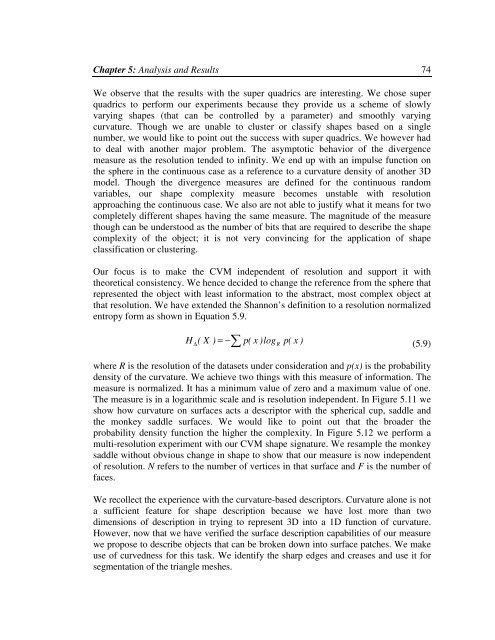To the Graduate Council: I am submitting herewith a thesis written by ...
To the Graduate Council: I am submitting herewith a thesis written by ...
To the Graduate Council: I am submitting herewith a thesis written by ...
You also want an ePaper? Increase the reach of your titles
YUMPU automatically turns print PDFs into web optimized ePapers that Google loves.
Chapter 5: Analysis and Results 74We observe that <strong>the</strong> results with <strong>the</strong> super quadrics are interesting. We chose superquadrics to perform our experiments because <strong>the</strong>y provide us a scheme of slowlyvarying shapes (that can be controlled <strong>by</strong> a par<strong>am</strong>eter) and smoothly varyingcurvature. Though we are unable to cluster or classify shapes based on a singlenumber, we would like to point out <strong>the</strong> success with super quadrics. We however hadto deal with ano<strong>the</strong>r major problem. The asymptotic behavior of <strong>the</strong> divergencemeasure as <strong>the</strong> resolution tended to infinity. We end up with an impulse function on<strong>the</strong> sphere in <strong>the</strong> continuous case as a reference to a curvature density of ano<strong>the</strong>r 3Dmodel. Though <strong>the</strong> divergence measures are defined for <strong>the</strong> continuous randomvariables, our shape complexity measure becomes unstable with resolutionapproaching <strong>the</strong> continuous case. We also are not able to justify what it means for twocompletely different shapes having <strong>the</strong> s<strong>am</strong>e measure. The magnitude of <strong>the</strong> measurethough can be understood as <strong>the</strong> number of bits that are required to describe <strong>the</strong> shapecomplexity of <strong>the</strong> object; it is not very convincing for <strong>the</strong> application of shapeclassification or clustering.Our focus is to make <strong>the</strong> CVM independent of resolution and support it with<strong>the</strong>oretical consistency. We hence decided to change <strong>the</strong> reference from <strong>the</strong> sphere thatrepresented <strong>the</strong> object with least information to <strong>the</strong> abstract, most complex object atthat resolution. We have extended <strong>the</strong> Shannon’s definition to a resolution normalizedentropy form as shown in Equation 5.9.H∆( X ) p( x )logR p( x )(5.9)= −where R is <strong>the</strong> resolution of <strong>the</strong> datasets under consideration and p(x) is <strong>the</strong> probabilitydensity of <strong>the</strong> curvature. We achieve two things with this measure of information. Themeasure is normalized. It has a minimum value of zero and a maximum value of one.The measure is in a logarithmic scale and is resolution independent. In Figure 5.11 weshow how curvature on surfaces acts a descriptor with <strong>the</strong> spherical cup, saddle and<strong>the</strong> monkey saddle surfaces. We would like to point out that <strong>the</strong> broader <strong>the</strong>probability density function <strong>the</strong> higher <strong>the</strong> complexity. In Figure 5.12 we perform <strong>am</strong>ulti-resolution experiment with our CVM shape signature. We res<strong>am</strong>ple <strong>the</strong> monkeysaddle without obvious change in shape to show that our measure is now independentof resolution. N refers to <strong>the</strong> number of vertices in that surface and F is <strong>the</strong> number offaces.We recollect <strong>the</strong> experience with <strong>the</strong> curvature-based descriptors. Curvature alone is nota sufficient feature for shape description because we have lost more than twodimensions of description in trying to represent 3D into a 1D function of curvature.However, now that we have verified <strong>the</strong> surface description capabilities of our measurewe propose to describe objects that can be broken down into surface patches. We makeuse of curvedness for this task. We identify <strong>the</strong> sharp edges and creases and use it forsegmentation of <strong>the</strong> triangle meshes.
















